Sign In
Welcome to AI Checker Sign in to continue your exploration of our platform with all its exciting features.
Forgot Password?
Don’t have an account ? Sign Up
Forgot Password
We'll Send You An Email To Reset Your Password.
Back to Login
Sign Up
Embrace the Future with AI Checker Sign up now and let's rewrite the possibilities together.
Already have an account? Sign In
Enter OTP
We'll send you an email to reset your password.
Back to Login
Enter OTP
We'll send you an OTP on your registered email address.
Back to Login
Confirm Password
Please enter your new password.
10 Proven Ways to Avoid AI Detection in College Papers
 Nathan Porter
Nathan Porter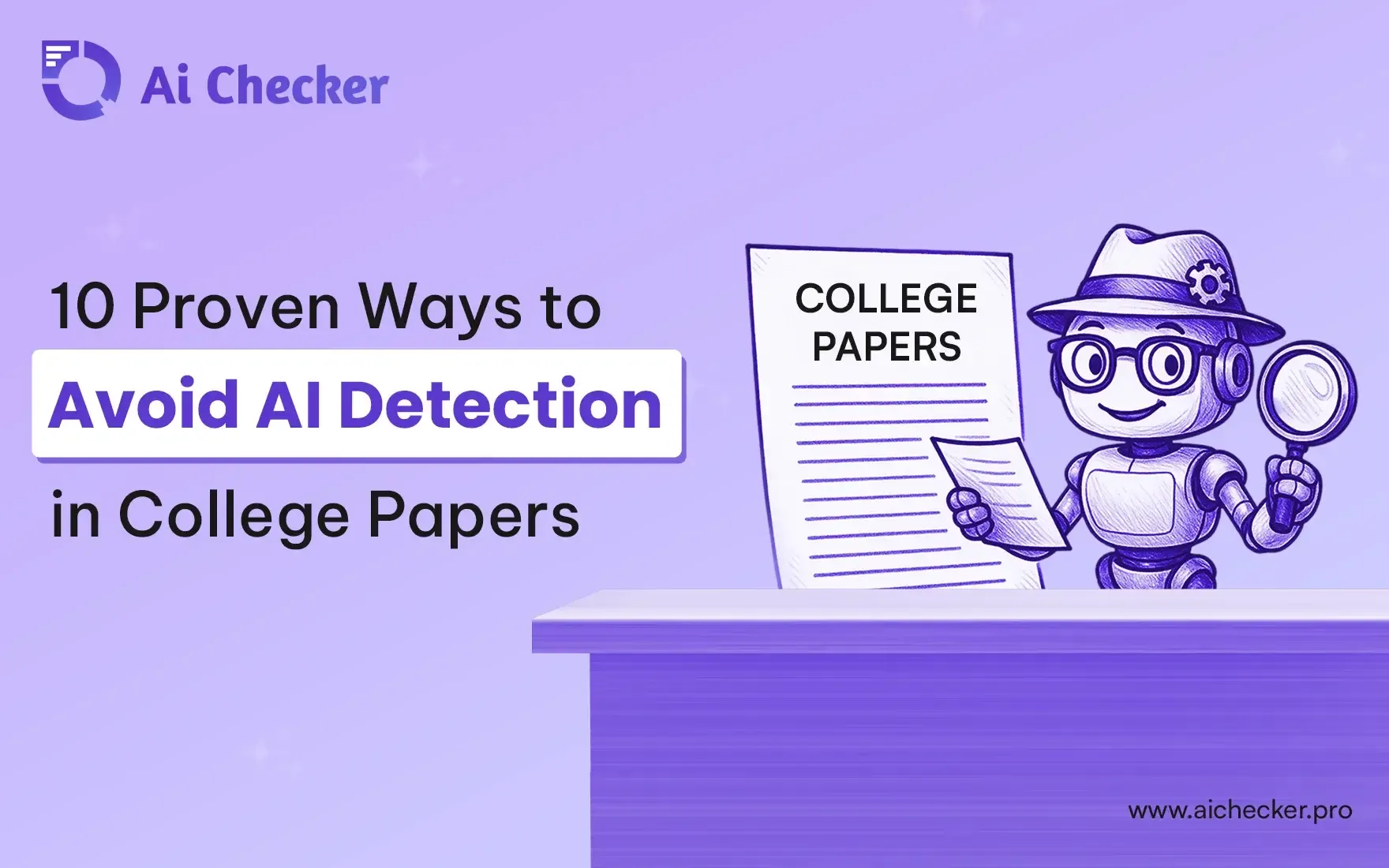
TABLE OF CONTENTS
The Growing Role of AI in College Writing
Why Students Depend on AI Tools
Why AI Detection Matters in Academia
The Rise of AI Detection Tools
Top 7 Tools Every Student Should Know
Limitations and Challenges of AI in Academic Writing
10 Proven Ways to Avoid AI Detection in College Papers
Conclusion
FAQs
In recent years, the process of writing academic papers has significantly changed. Numerous advanced AI-powered applications have been developed, which help students write faster and with better quality. But this development raises a new issue: software that can recognize if a paper was written by a person or with the assistance of a computer program.
If you are presently in college, you have probably heard of AI detectors. These detectors are specially designed software programs used by teachers or schools to check if an AI-assisted tool (such as ChatGPT) was used in writing a paper. This handbook will provide you with everything you need to know about AI detection, and list 10 evidence-based practices that can assist you in writing papers that are authentic and pass as human-written work.
The Growing Role of AI in College Writing
AI writing tools have gained significant popularity among students. Applications such as ChatGPT, Gemini, and Claude are equipped to assist in brainstorming, organizing ideas, and composing entire paragraphs. Recent polling data shows that more than 30% of college students have used one of these AI tools in their coursework.
These tools are smart and helpful. They can:
Generate essay outlines in seconds
Explain difficult topics in simple words
Help you find sources and references
Fix grammar and spelling mistakes
Suggest better ways to phrase your ideas
Why Students Depend on AI Tools
Students turn to AI for many good reasons:
1. Time constraints: College is a busy time. Between classes, part-time jobs, and social commitments, it can be a challenge for students to complete all of the work required for a given course or program. An AI checker or writing assistant will help speed up the research and drafting process.
2. Macro issues, like language barriers: Many international students are still learning English and find that using AI interfaces assists with grammar, sentence structure, and a variety of related tasks and issues.
3. Learning support: AI can help explain complex topics in simpler language, which may help students to better understand complex subjects before they begin writing about them.
4. Writing comfort and confidence: Some students, especially those with less experience, may feel nervous about their writing ability. AI tools offer a starting point and a sense of confidence as they begin writing.
Whatever the case, the responsibility to self-advocate lies with the student! Many schools will want to ensure students can learn and think for themselves, rather than copy what a computer would write.
Why AI Detection Matters in Academia
AI detection in colleges protects academic integrity by ensuring students submit original work, showcase real learning, and build critical thinking skills.
Academic Integrity and Originality
Colleges and universities take academic integrity very seriously. When you submit a paper, your professor expects it to represent YOUR thoughts, YOUR comprehension, and YOUR creativity. This is known as academic integrity.
Here is a way to explain this: If you were learning to play the guitar, you would want to practice by yourself. Watching someone else play will not make you better at playing. The same goes for your writing. The experience of researching, thinking, and writing will help you learn about yourself as a student.
Original work matters because it:
Shows what you have actually learned
Builds your critical thinking skills
Demonstrates your capacity to analyze
Prepares you for the world.
Consequences of Getting Flagged
Getting caught using AI to write your papers can lead to serious problems:
1. Nobody wants bad grades: Professors may give zero points for AI work. This can really hurt your grade.
2. Academic probation: Academic probation means the college or university will be keeping a close watch on you and note more serious consequences after this if you continue to engage in academic dishonesty, especially for the university and campus.
3. Reputation among colleagues: Any academic world will spread. Professors talk. So, once you have a dishonest reputation, it will follow you to other items' placement.
4. Possible loss: If caught for academic dishonesty, you could lose a scholarship you counted on, lose an internship for which you have an opportunity, or receive a recommendation from a professor to get into a graduate program.
5. Expulsion: In the most serious cases, students can face permanent expulsion from their college or university.
None of these possibilities is meant to scare you; they are to show the need to use these tools in a responsible and ethical way.
The Rise of AI Detection Tools
AI detectors analyze text for patterns, predictability, and sentence structures to distinguish human writing from AI-generated content.
How AI Detectors Work
An AI detector functions like an intelligent investigator who seeks clues in your writing. AI content detectors rely on complicated algorithms (step-by-step instructions for computers) to analyze text and determine whether it was written by an AI or a human.
What an AI content detector looks for is the following
1. Patterns: AI writing tools typically imitate patterns and phrases. AI content detectors notice these repeated patterns.
2. Consistency: Mistakes and inconsistencies arise when humans write. AI writing is typically too consistent and perfect.
3. Predictability: AI tools predict words based on probability that is, what word goes next. A ChatGPT checker looks for word predictability.
4. Sentence structure: AI operates on sentence lengths and repeats sentence structures. Human writing is more varied and unpredictable.
5. Perplexity and burstiness: The measure of how surprising the word choice was (perplexity) and the measure of how varied the sentence lengths were (burstiness). Human writing has greater perplexity and burstiness scores.
Common Triggers That Get Students Caught
Certain things make an AI writing detector suspicious:
1. Generic expressions: AI-generated writing uses phrases like "It's worth noting that" or "In today's world" far too often.
2. Too perfect grammar: Human beings are capable of making minor mistakes. If your writing is absolutely flawless with no errors or typos, this looks very suspicious.
3. No personal examples: AI cannot provide personal experiences or unique observations from your own life.
4. Consistent tone: The mood and energy of your writing should vary from time to time. AI maintains the same tone from beginning to end.
5. Lack of depth: AI tends to provide an analysis that is not deep. Real understanding is necessary for a true depth of analysis.
6. Inappropriate vocabulary: Artificial Intelligence uses words that sound fancy but really aren't quite right for the context.
Top 7 Tools Every Student Should Know
Let's explore the most popular AI detection tools that teachers and schools use:
1. AI Checker Pro
AI Checker Pro is a popular AI detector tool that many educational institutions trust. It scans your paper and gives it a percentage score showing how much of your writing might be AI-generated.
Features:
Fast scanning (results in under 30 seconds)
Highlights specific sentences that seem AI-written
Provides a detailed report
Can check papers up to 50,000 words
Accuracy: About 85-90% accurate according to independent tests.
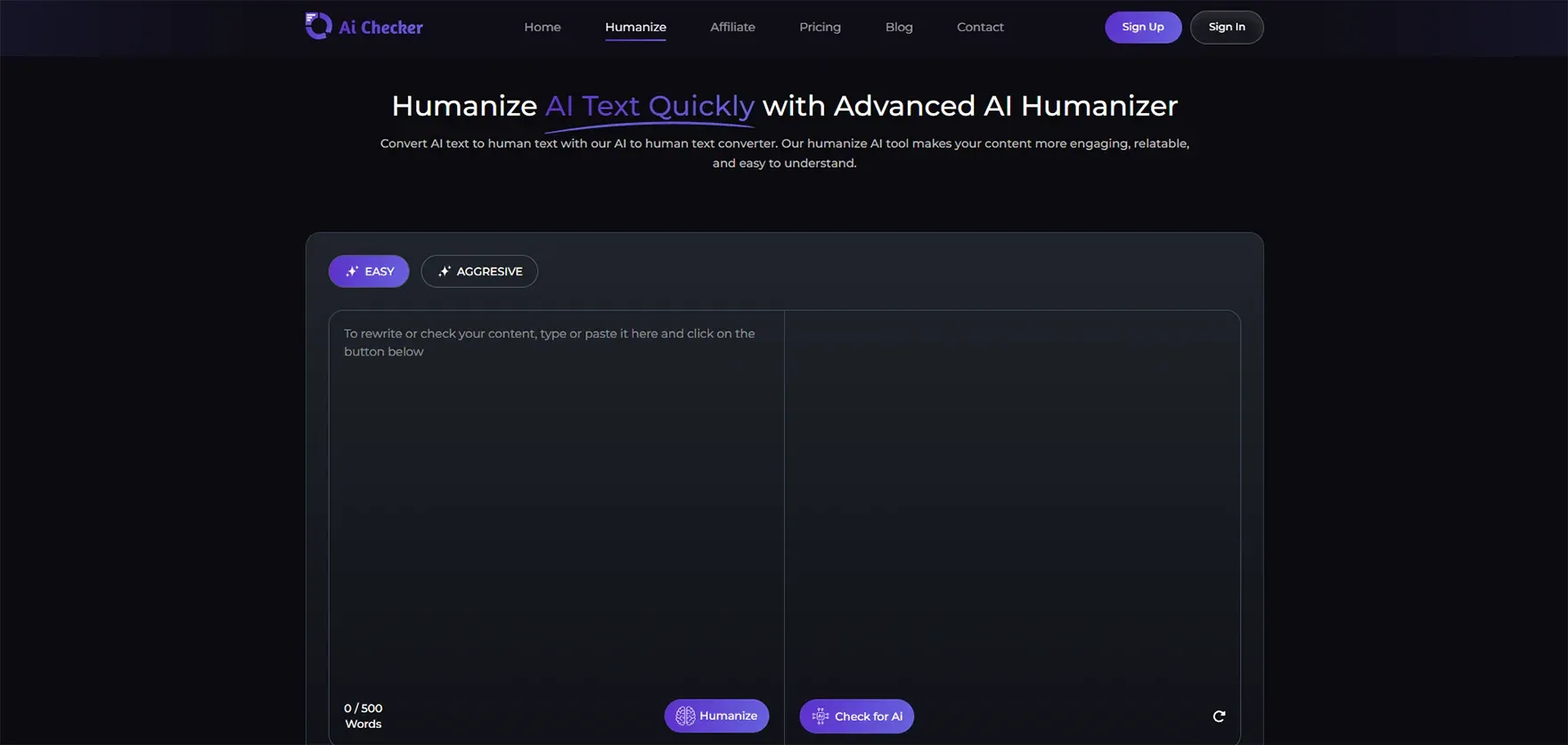
2. AssignmentGPT AI
AssignmentGPT AI specializes in detecting AI writing in academic assignments. It's designed specifically for students and teachers.
Features:
Compares your writing to known AI patterns
Offers suggestions for making your writing more human
Works with multiple languages
Provides before-and-after comparisons
Best for: Students who want to check their work before submitting.
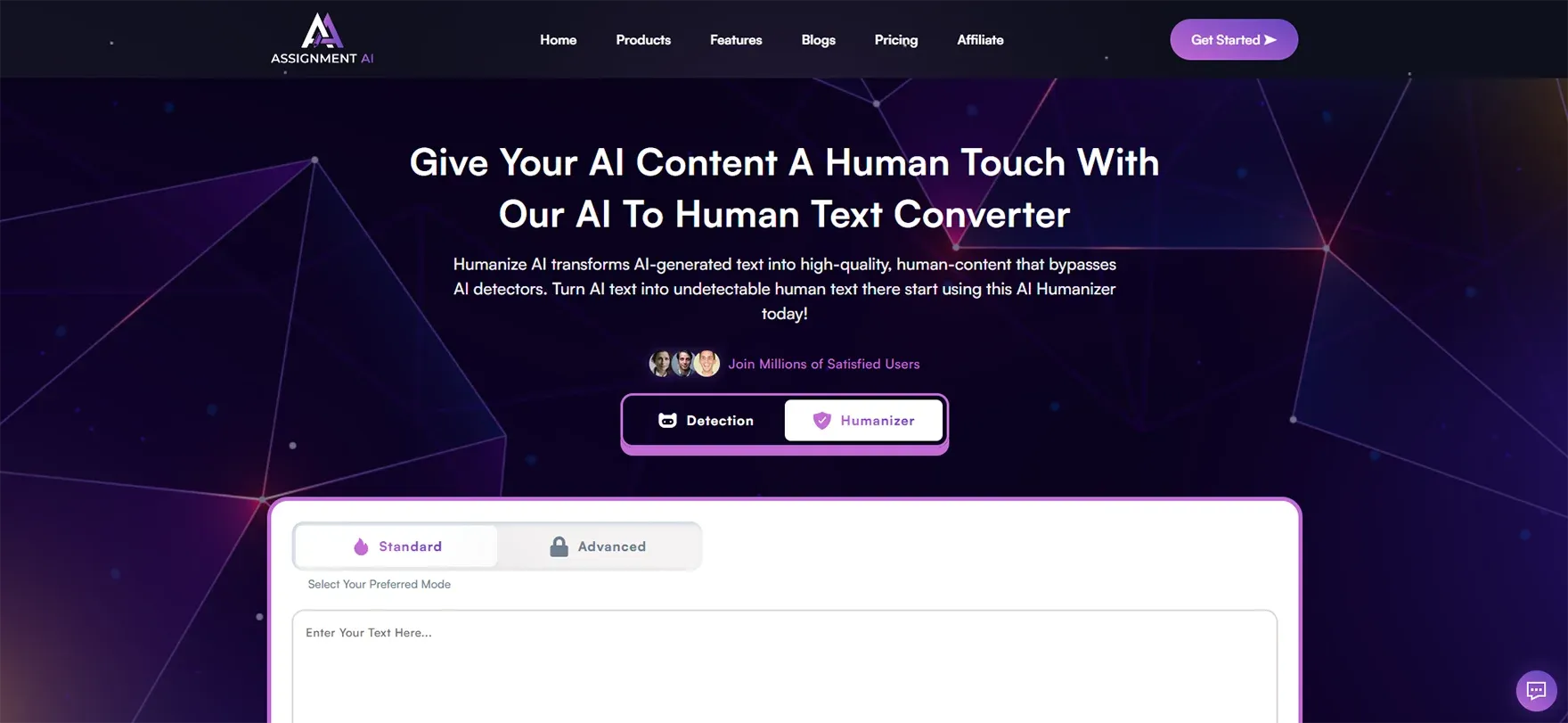
3. Bypassai.io
Despite its name, Bypassai.io is actually an AI detector for essays that helps you understand how your writing might be perceived by detection software.
Features:
Shows which parts of your text trigger detection
Offers explanations for why certain sections are flagged
Provides rewriting suggestions
Free version available with limited features
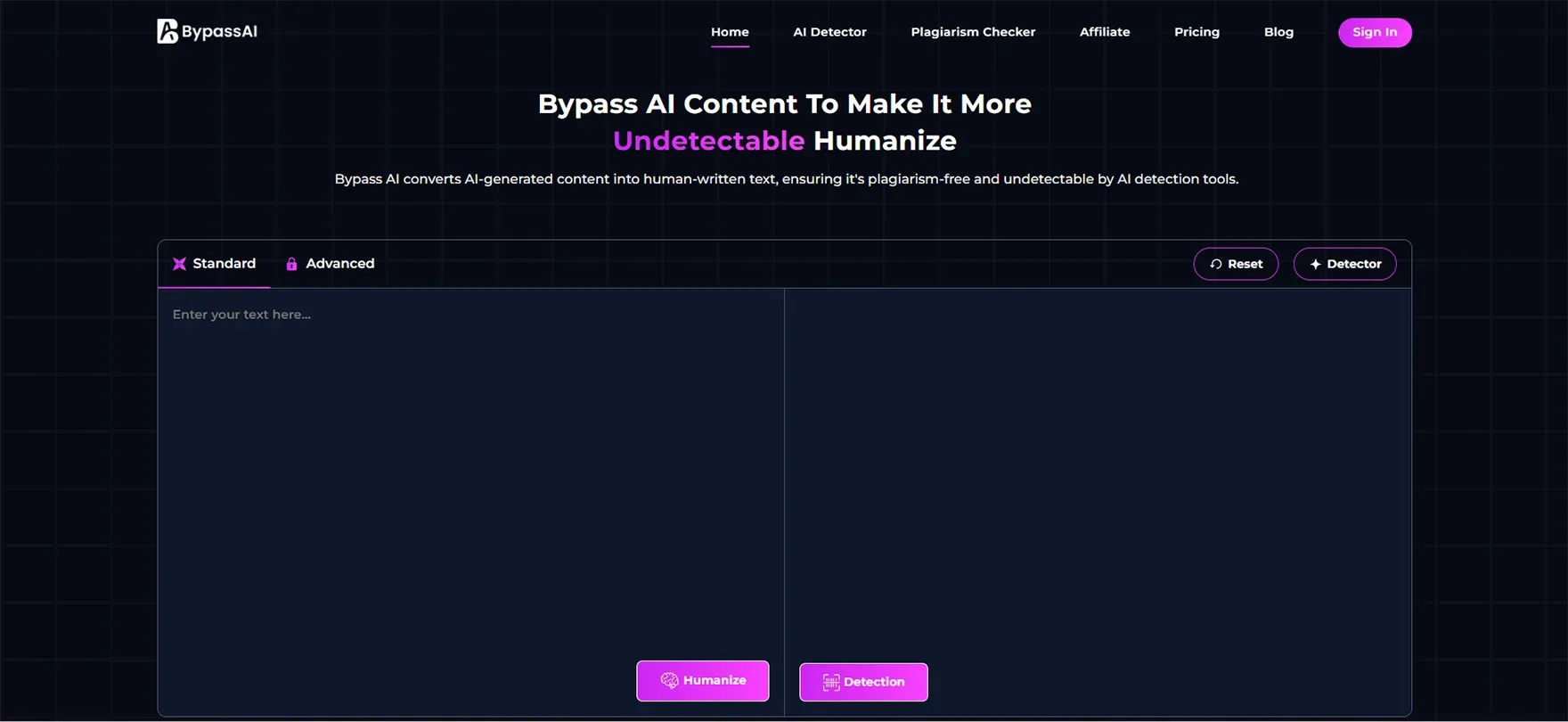
4. ZeroGPT AI
ZeroGPT AI is a free AI detector that's easy to use and quite accurate. Many students use it to check their work before submission.
Features:
Simple, user-friendly interface
No account required
Instant results
Highlights every sentence with a risk score
Accuracy: Around 80-85% accurate for detecting pure AI content.
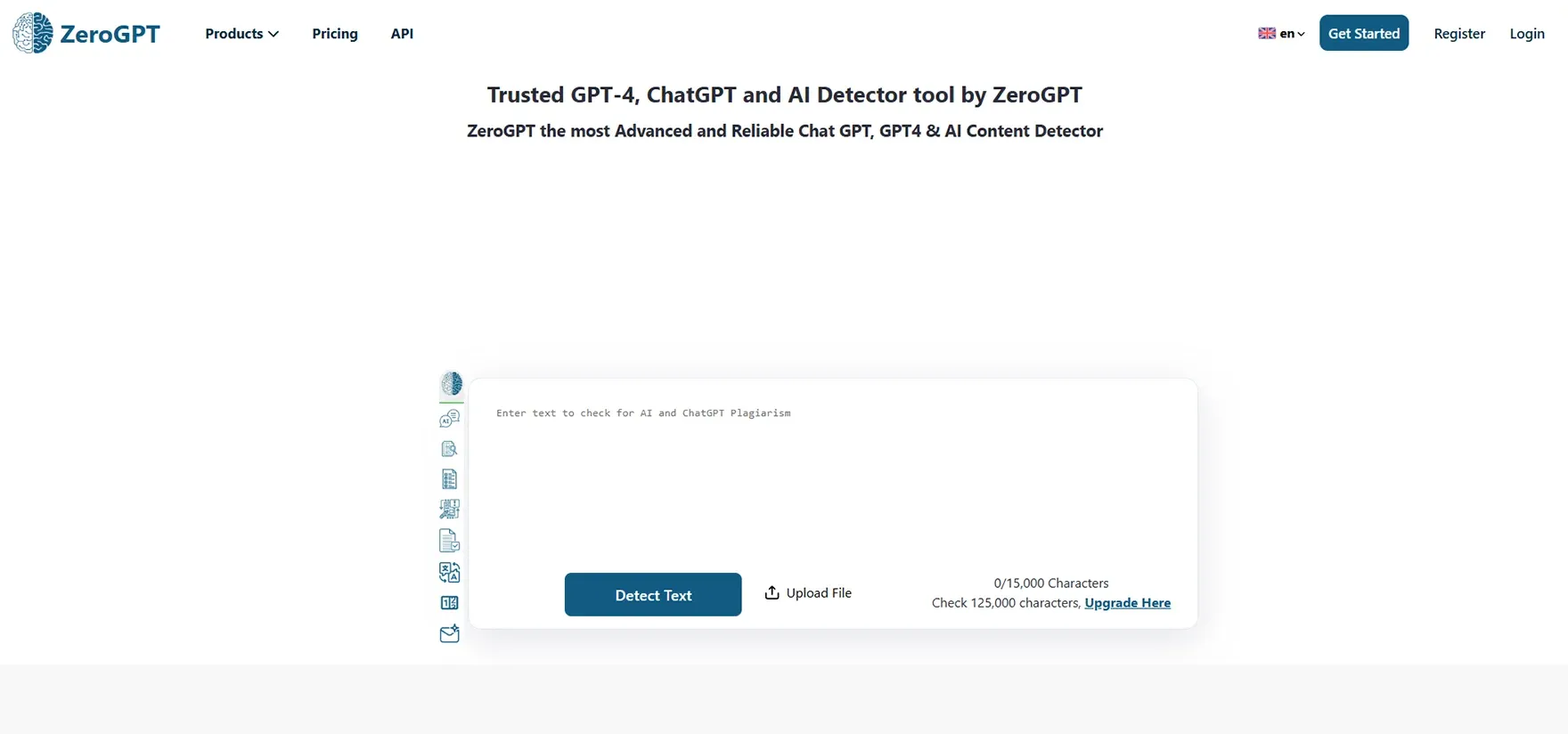
5. Quillbot AI
While Quillbot is famous for paraphrasing, it also includes an AI detector tool as part of its suite.
Features:
Integrated with grammar checker and paraphraser
Shows detection confidence levels
Provides writing improvement suggestions
Premium and free versions available
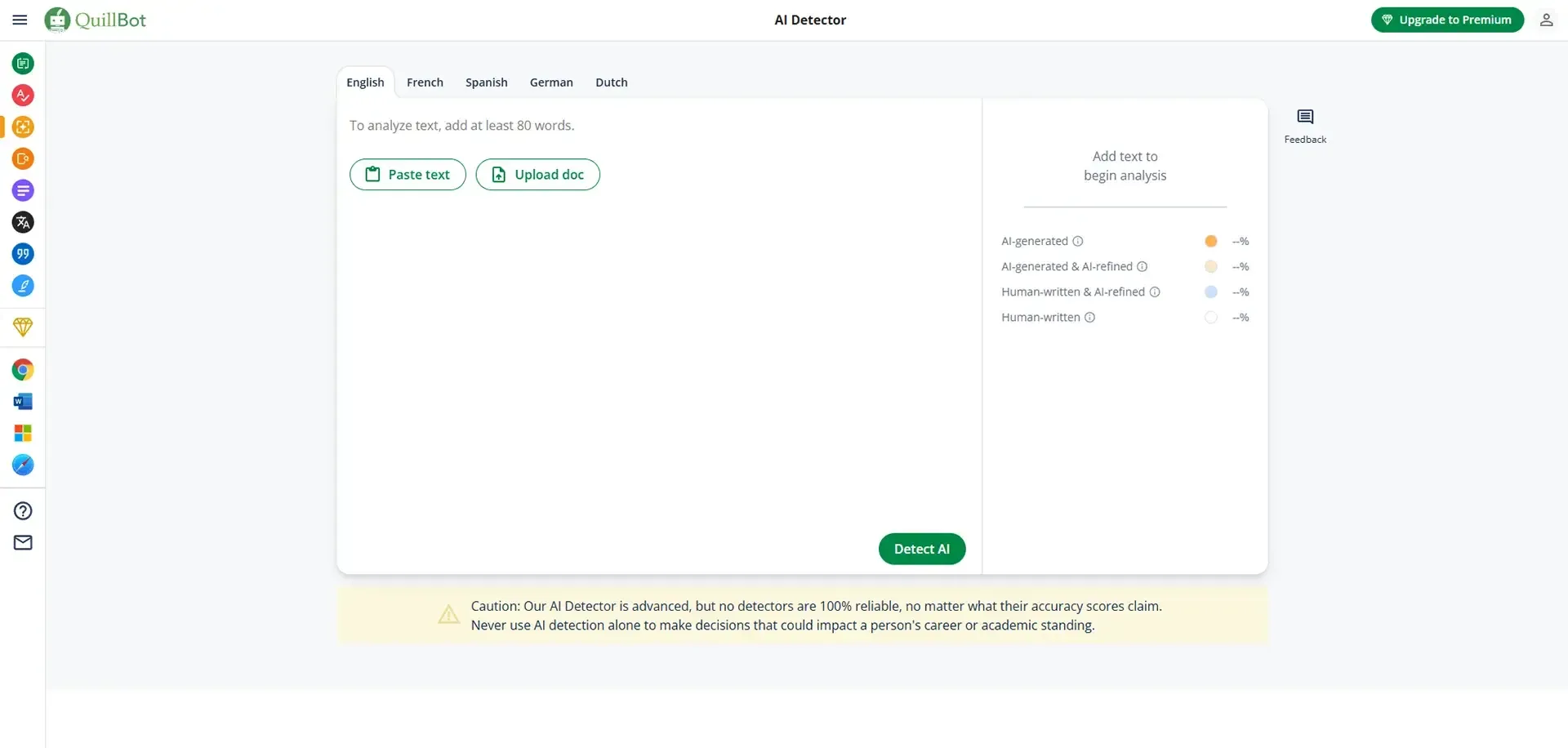
6. Turnitin
Turnitin is the most famous plagiarism checker used by universities worldwide. It recently added AI detection capabilities.
Features:
Highly trusted by academic institutions
Checks both plagiarism and AI content
Provides detailed similarity reports
Only available to schools (students can't access it directly)
Accuracy: Turnitin claims 98% accuracy for detecting AI writing, though independent tests show it's closer to 85-90%.
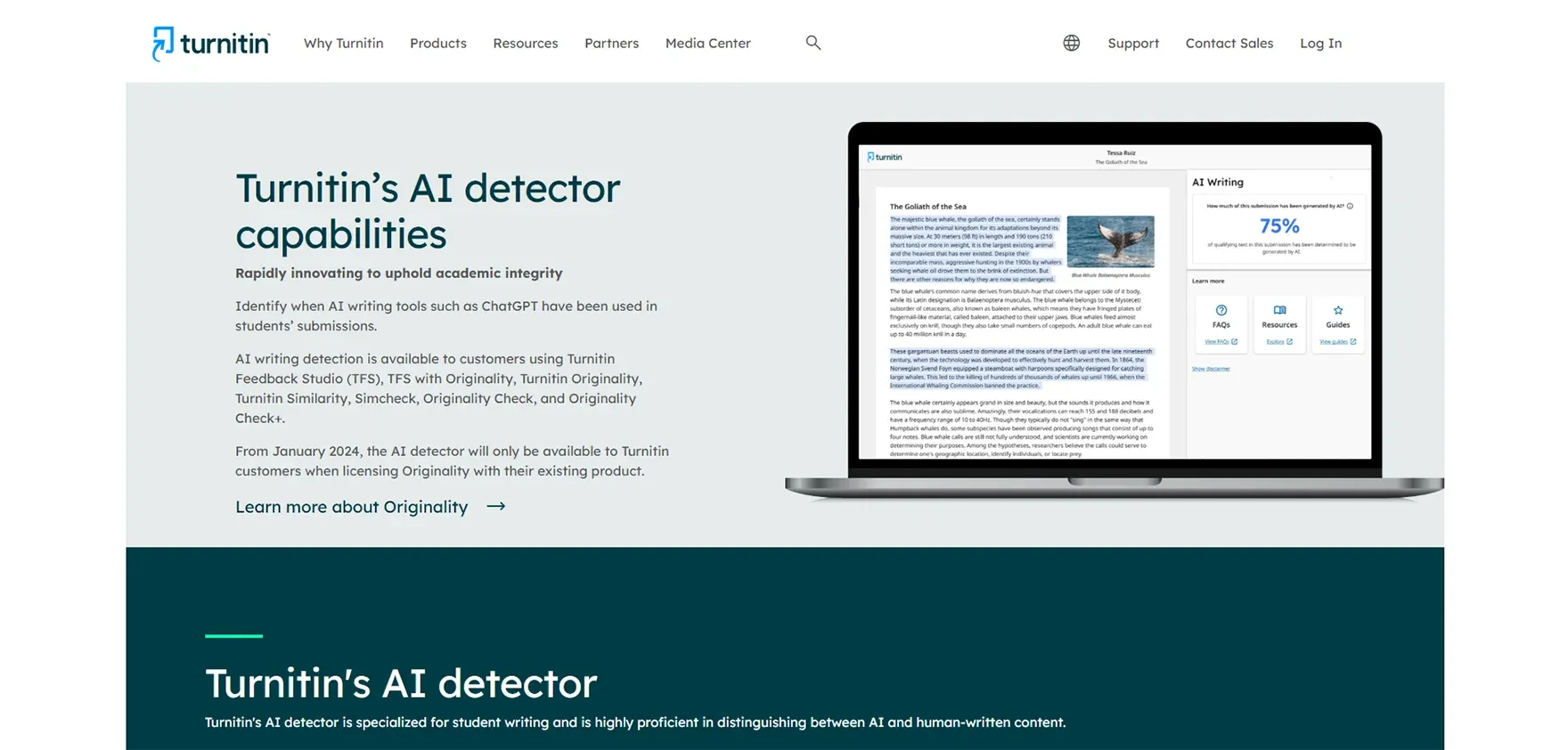
7. Originality.AI
Originality AI content detector is popular among professional writers and educators for its accuracy and detailed analysis.
Features:
Scans for both AI and plagiarism
Provides readability scores
Batch checking for multiple documents
API access for institutions
Best for: Teachers and schools that need to check many papers quickly.

Limitations and Challenges of AI in Academic Writing
Before we dive into how to avoid detection, it's important to understand the limitations and challenges around AI detection.
1. Accuracy Issues with AI Detectors
No AI detector is perelleathe completely accurate. In fact, the best AI detectors can be wrong! Even research found that many AI detectors are only 60-95% accurate, depending on the specific AI detector and the specific text.
This creates uncertainty for both the student and the teacher. A score that is low does not mean you plagiarized or cheated, while a high score does not mean you wrote all of the paper yourself.
2. False Positives and False Negatives
False positives happen when the detector says your writing is AI-generated, but you actually wrote it yourself. This can happen if:
You write in a very formal, structured way
English is your second language and you use simple, textbook-style sentences
You're writing about technical topics with specific terminology
False negatives occur when AI-written content goes undetected. This happens when:
The AI text has been heavily edited
Multiple AI tools were combined
The writer mixed AI content with their own writing
3. Over-Reliance on AI for Writing
One of the biggest concerns is that students might depend too much on AI tools. If you always use AI to write for you, you won't develop important skills like:
Critical thinking and analysis
Research abilities
Argument construction
Personal writing voice
Time management
These skills are essential for your career, not just for passing classes.
4. Ethical and Integrity Concerns
There's an ongoing debate about what counts as "cheating" when it comes to AI:
Is using AI for brainstorming okay?
What about using it to improve grammar?
Where's the line between "help" and "doing the work for you"?
Different schools have different rules. Some allow AI use with proper citation, others ban it completely. Always check your school's policy.
5. Limitations in Understanding Context & Creativity
AI tools have important limitations:
They don't understand context the way humans do
They can't have real opinions or personal experiences
They struggle with nuance, emotion, and creativity
They sometimes provide incorrect information confidently
They can't truly understand what they're writing about
This is why purely AI-written papers often feel shallow or miss the point of the assignment.
10 Proven Ways to Avoid AI Detection in College Papers
Now for the main part of this guide. Here are 10 proven strategies to make your writing sound more human and authentic:
1. Avoid Overusing Predictable Vocabulary
Artificial intelligence tools have a fondness for certain words or phrases. They repeat these words and phrases incessantly because these words appear associated with many phrases in training data.
Words to avoid overusing:
"Delve into"
"Landscape" (as in "business landscape")
"It is important to note that"
"Moreover" or "Furthermore" at the start of every paragraph
"In conclusion" or "To summarize"
"Myriad" or "plethora"
Instead, an idea uses natural speech you’d actually use when speaking. Change your transition
word usage. If you wouldn’t state it aloud, don’t write it.
Example:
AI-style: "It is important to note that climate change presents a myriad of challenges to our society."
Human-style: "Climate change creates many serious problems for us today."
2. Write with a Personal Touch
This is the most powerful way to avoid AI detection. Add personal elements that only you can provide.
Ways to personalize your writing:
Share a brief, relevant story from your life
Mention something specific about your campus, community, or experience
Reference conversations you've had with classmates or professors
Include observations from your own research or experiments
Express genuine opinions and explain WHY you think that way
Example: "Last semester, I volunteered at a local food bank, and I saw firsthand how inflation affects families. The number of people needing help increased by almost 40% compared to the previous year. This experience changed how I think about economic policy."
An AI detector can't flag this as AI-written because it contains unique, specific details only you would know.
3. Keep Sentences Natural and Varied
Human writers naturally mix short and long sentences. We write how we think, which isn't always perfectly structured.
The rhythm matters:
Short sentences add impact. They make points clear.
Longer sentences allow you to explore ideas more fully, connect related thoughts, and add nuance to your arguments.
Mixing both creates a natural reading rhythm.
AI tends to write: "The research indicates significant findings. The data support this conclusion. These results have important implications."
Humans write more like: "The research shows some surprising results. What makes them interesting is how they challenge what we thought we knew before. This could change how scientists approach this problem going forward."
Notice how the human version has varied sentence lengths and a more conversational feel?
4. Paraphrase Instead of Copy-Pasting
If you use AI to generate ideas, never copy-paste directly. Always rewrite in your own words.
The paraphrasing process:
Read the AI-generated content
Close that tab or look away from the screen
Think about what you just read
Write it again in your own words, from memory
Check that you captured the key ideas but in YOUR voice
This forces you to actually process the information, which helps you learn AND makes your writing sound more human.
AI output: "The implementation of renewable energy sources represents a paradigm shift in how societies approach power generation, offering sustainable alternatives to fossil fuel dependency."
Your paraphrase: "More countries are switching to renewable energy like solar and wind power. This change helps reduce our reliance on oil and coal, which is better for the environment."
5. Mix Research with Personal Analysis
A strong paper combines outside research with your own thinking. After presenting facts or quotes from sources, add your interpretation.
Structure to follow:
Present evidence or expert opinion
Explain what it means
Connect it to your main argument
Add your own insight or critical analysis
Example: "According to Dr. Sarah Martinez's 2024 study, students who take handwritten notes retain 25% more information than those who type. This makes sense when you think about it. When you write by hand, you can't capture everything word-for-word, so your brain has to process and summarize as you go. I've tested this in my own classes and found that I remember lectures better when I handwrite notes, even though it takes longer."
Notice how this combines research (the study), explanation, and personal observation? That's what makes writing sound human.
6. Edit and Proofread Like a Human
This might sound strange, but papers with small, natural mistakes sometimes avoid detection better than perfectly polished ones.
I'm NOT suggesting you submit sloppy work. But understand that:
Humans occasionally use contractions (don't, can't, won't)
We sometimes start sentences with "And" or "But" for emphasis
Our papers might have minor inconsistencies in style
We use informal phrasing occasionally, even in academic writing
Don't make your paper artificially messy, but don't stress about making it robotically perfect either.
Focus your proofreading on:
Checking that your ideas flow logically
Making sure you actually answered the assignment question
Verifying your sources are cited correctly
Removing repetitive phrases
Ensuring your voice stays consistent
7. Add Your Own Voice and Ideas
Your voice is your unique way of expressing ideas. It includes:
The words you naturally choose
How you structure arguments
Your sense of humor (when appropriate)
Your level of formality
Your personal perspective
Finding your voice:
Read your paper out loud. Does it sound like you talking?
Imagine explaining your topic to a friend. Write more like that.
Don't try to sound super formal or academic if that's not natural for you
Include phrases you actually use: "What's interesting is..." or "Here's the thing..."
Example of voice: Without voice: "The study produced results that warrant further investigation."
With voice: "The study found something surprising that researchers need to look into more. The results don't match what previous studies showed, which raises some interesting questions."
The second version sounds like a real person explaining something they find intriguing.
8. Run a "Humanization" Pass Before Submitting
After you finish your paper, do a final read-through specifically to add human elements.
Your humanization checklist:
✓ Did I include at least one personal observation or example?
✓ Does my introduction grab attention with something specific, not generic?
✓ Are my sentences varied in length and structure?
✓ Did I avoid repeating the same transition words?
✓ Does my conclusion reflect my actual thoughts, not just summarize?
✓ Would someone who knows me recognize my writing style?
✓ Did I avoid words and phrases that sound too formal or AI-like?
Go through each section and ask: "Would a human really write this sentence exactly this way?" If not, change it.
9. Check for Plagiarism and AI Flags
Before you submit your paper, run it through detection tools yourself. Many free AI detectors are available online.
Testing your paper:
Use a free AI detector like ZeroGPT or Quillbot's detector
Check which sections get flagged
Rewrite those sections in your own words
Test again until you get a low AI detection score
Also run it through a plagiarism checker like Grammarly or Quetext
Important: If your paper gets a high AI detection score and you wrote it yourself, don't panic. This might be a false positive. Try:
Making your language less formal
Adding more varied sentence structures
Including personal touches
Breaking up long, complex sentences
10. Use AI as a Helper, Not a Writer
This is the golden rule. AI should be your research assistant, not your ghostwriter.
Good ways to use AI:
✓ Brainstorming topic ideas
✓ Creating an outline structure
✓ Explaining concepts you don't understand
✓ Suggesting sources to research
✓ Helping you rephrase awkward sentences YOU wrote
✓ Checking your grammar and spelling
✓ Providing examples to illustrate points you're making
Bad ways to use AI:
✗ Asking it to write your entire paper
✗ Copy-pasting paragraphs without rewriting
✗ Using AI-generated arguments without developing them yourself
✗ Letting AI do your thinking for you
✗ Submitting AI-written work as your own
The right approach: Think of AI like a study buddy who helps you understand things and gives you ideas, but YOU do the actual work. You're developing skills you'll need for your career. AI won't be there to write reports for you at your future job, so learn to write well yourself now.
Conclusion
Avoiding detection is not about fooling the systems it’s about writing from an honest perspective and developing your own voice. Use AI detectors as aids, not as substitutes for applying your own thinking. Include personal examples when possible, vary your sentences, and strive to make your writing sound like how you really think.
Keep in mind the following:
AI detectors are never perfect conversations, and your normal writing conventions is your best defense.
The process of writing for yourself creates the kind of skills that allow you to write effectively for a lifetime.
It's simply not worth the chance that you will get caught.
Pro Tip: Before submitting your paper, review it with an AI detection tool such as AIChecker.pro which may be one of the best free AI detection tools. It will help you get your final work to sound more human.
You can style your writing honestly, you can use AI responsibly your true voice should shine through. Your education is an investment that prepares you for the rest of your life, make it worthwhile and invest in yourself.
FAQs
1. What is an AI detector in college writing?
An AI detector is software that analyzes student papers to identify whether they were written by humans or generated with AI tools like ChatGPT.
2. Why do colleges use AI detection tools?
Schools use them to protect academic integrity, ensure originality, and verify that students are actually learning and developing their own skills.
3. What happens if my paper gets flagged as AI-generated?
Consequences can range from receiving a zero on the assignment to probation, loss of scholarships, or even expulsion in severe cases.
4. How accurate are AI detectors?
Accuracy varies. Some tools claim 90%+, but false positives and false negatives are common—meaning detectors aren’t perfect.
5. What writing habits trigger AI detectors?
Overuse of generic phrases, flawless grammar, repetitive structures, and lack of personal stories or analysis often raise red flags.
6. What are the best AI detection tools used in colleges?
Popular tools include Turnitin, Originality.AI, ZeroGPT, Quillbot AI detector, and AI Checker Pro. Many schools rely on Turnitin’s built-in AI detection.
7. How can I make my papers sound more human?
Add personal examples, vary sentence lengths, paraphrase instead of copy-pasting, use natural vocabulary, and include your own analysis and opinions.

Nathan Porter
Content writer at @Aichecker
I am a content writer at AI Checker Pro, where I craft engaging, SEO-optimized content to enhance brand visibility and educate users about our AI-driven solutions. My role involves creating clear, impactful messaging across digital platforms to drive engagement and support company growth.



